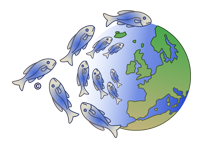

Clavelina lepadiformis is a colonial ascidian living in groups of 3 to 3OO zooids. They are elongated, cylindrical and up to 2 cm tall. The test is smooth and completely transparent so that the branchial sac is clearly visible. The endostyle, the dorsal axis, the margin of the oral and atrial siphons as well as the upper part of the pharynx are underlined by a thin white or yellowish line. The zooids are joined together by a short basal stolon that cling on rocks, seaweeds or piles.
Clavelina lepadiformis is found from surface to 50 m deep in the Atlantic Ocean, the North Sea, the English Channel and in the Mediterranean Sea.
Source : World Register of Marine Species
Biota (Superdomain)
Animalia (Kingdom)
Chordata (Phylum)
Tunicata (Subphylum)
Ascidiacea (Class)
Aplousobranchia (Order)
Clavelinidae (Family)
Clavelina (Genus)
Clavelina lepadiformis (Species)
Zooid : individual, single animal.
Test : or tunic: thick layer secreted by the mantel containing cellulose and protecting the animal.
Oral siphon : opening by which water is drawn in the ascidian.
Atrial siphon : opening through which water is expelled.
Endostyle : groove through which food particles are moved up to the oesophagus.
Stolon : root-like element binding together the individuals of a colony.
Text : Anne Bay-Nouailhat © 2005 - 2026.
Photos : ©
Wilfried Bay-Nouailhat. Published with his kind permission.
Websites and reference works : Consult bibliography
Image satellite: © Esri, DigitalGlobe, GeoEye, Earthstar Geographics, CNES/Airbus DS, USDA, USGS, AeroGRID, IGN, and the GIS User Community.
Données de distribution : Clavelina lepadiformis (Müller, 1776) in GBIF Secretariat (2019). GBIF Backbone Taxonomy. Checklist dataset https://doi.org/10.15468/39omei accessed via GBIF.org on 2026-01-07.
Source : World Register of Marine Species
Biota (Superdomain)
Animalia (Kingdom)
Chordata (Phylum)
Tunicata (Subphylum)
Ascidiacea (Class)
Aplousobranchia (Order)
Clavelinidae (Family)
Clavelina (Genus)
Clavelina lepadiformis (Species)
Zooid : individual, single animal.
Test : or tunic: thick layer secreted by the mantel containing cellulose and protecting the animal.
Oral siphon : opening by which water is drawn in the ascidian.
Atrial siphon : opening through which water is expelled.
Endostyle : groove through which food particles are moved up to the oesophagus.
Stolon : root-like element binding together the individuals of a colony.
Text : Anne Bay-Nouailhat © 2005 - 2026.
Photos : ©
Wilfried Bay-Nouailhat. Published with his kind permission.
Websites and reference works : Consult bibliography
Bay-Nouailhat A., September 2005, Description of Clavelina lepadiformis, [On line] https://european-marine-life.org/32/clavelina-lepadiformis.php, consulted on 2026 January 07.
Author

Chargée d’études en environnement marin
Plongeuse professionnelle - Naturaliste
© Mer et littoral 2004-2026 - All rights reserved
The texts and images on this website are not free of rights and cannot be copied and/or used without the agreement of their respective authors.